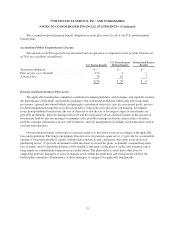UPS 2009 Annual Report Download - page 77
Download and view the complete annual report
Please find page 77 of the 2009 UPS annual report below. You can navigate through the pages in the report by either clicking on the pages listed below, or by using the keyword search tool below to find specific information within the annual report.UNITED PARCEL SERVICE, INC. AND SUBSIDIARIES
NOTES TO CONSOLIDATED FINANCIAL STATEMENTS—(Continued)
Restricted Cash
Restricted cash and cash equivalents relate to our self-insurance requirements. In 2008, we entered into an
escrow agreement with an insurance carrier to guarantee our self-insurance obligations. This agreement requires
us to provide cash collateral to the insurance carrier, which is classified as other non-current assets on our
consolidated balance sheet. Additional cash collateral provided is reflected in other investing activities in the
cash flow statement. This restricted cash is invested in money market funds and similar cash equivalent type
assets. As of December 31, 2009 and 2008, we had $286 and $191 million in restricted cash, respectively.
Fair Value Measurements
Marketable securities utilizing Level 1 inputs include active exchange-traded equity securities and equity
index funds, and most U.S. Government debt securities, as these securities all have quoted prices in active
markets. Marketable securities utilizing Level 2 inputs include non-auction rate asset-backed securities, corporate
bonds, and municipal bonds. These securities are valued using market corroborated pricing, matrix pricing, or
other models that utilize observable inputs such as yield curves.
We have classified our auction rate securities portfolio as utilizing Level 3 inputs, as their valuation requires
substantial judgment and estimation of factors that are not currently observable in the market due to the lack of
trading in the securities. The valuation may be revised in future periods as market conditions evolve. These
securities were valued as of December 31, 2009 considering several factors, including the credit quality of the
securities, the rate of interest received since the failed auctions began, the yields of securities similar to the
underlying auction rate securities, and the input of broker-dealers in these securities.
We maintain holdings in certain investment partnerships that are measured at fair value utilizing Level 3
inputs (classified as “other investments” in the tables below, and as “Other Non-Current Assets” in the
consolidated balance sheet). These partnership holdings do not have any quoted prices, nor can they be valued
using inputs based on observable market data. These investments are valued internally using a discounted cash
flow model based on each partnership’s financial statements and cash flow projections.
65
























